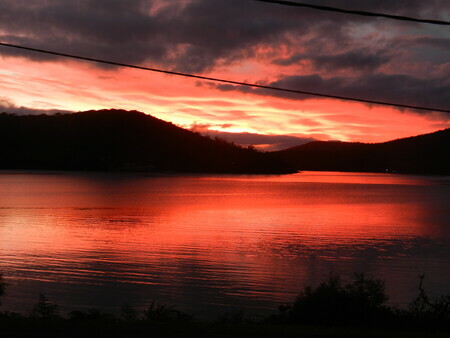| Home | | | Bio | | | Gallery | | | Events | | | Blog | | | Guestbook | | | Mailing List | | | Links | | | Contact |
Blog
Hard and yet easy to believe that it's been over a month since I've posted. There's been so much to do, with getting our new place sorted after leading a nomadic life, with all our possessions in storage, since January 1. And I think there's lots to be said for that too!
However, it's great to have a home again, and a beautiful one at that. Every time I look out at the garden, or drive past Okanagan Lake, I marvel at how fortunate I am to live in such a gorgeous place in the world. Not that I haven't seen lots this year!
Summerland is turning out to be even more of an artistic haven than I suspected. Within 3 days of moving in I found a show at the Shatford Art Centre in Penticton to put entries into. After a little digging I found three pieces that met the criteria and by last week they were viewed at the opening of an exhibition to honour the founders of the centre--those local patrons of the arts who funded this very active community art centre. Apparently one of my pieces garnered some votes for favourites, cast by the founders--but not quite enough to take any prizes.
I've also found time to get my 2013 calendars ordered (they should be arriving any day now)--same desktop style as the last few years, and a lower price ($12)--so if you want some put your order in! I've sold about 20% of them already. I've also ordered some new cards and magnets for the shows I have coming up, and for the two galleries that I'll be exhibiting in for Christmas, as well as on-going (Comox Valley Art Gallery Gift Shop and the Summerland Art Gallery shop).
I was pleased to hear that one of my canvas-wrap mermaid reproductions had sold, too!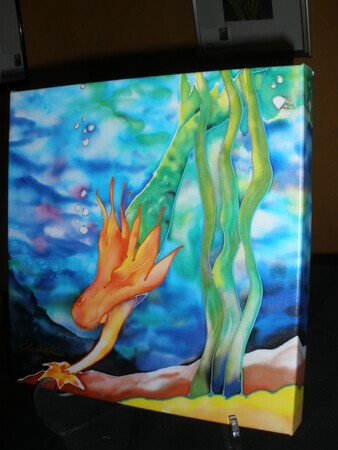 I'll be ordering a few more for my sales in November, as well as some canvas wraps in various sizes of "Faerie Woods" which I think will look super.
I'll be ordering a few more for my sales in November, as well as some canvas wraps in various sizes of "Faerie Woods" which I think will look super.
Also on the art front I've been working away on my new studio/gallery which, upon measurement, is going to be over 600 square feet! (And I've been scrubbing every inch of the concrete floor to get ready to put a stain finish on it). This detached building on the property has already had a few lives including storage shed for all our possessions for the last year, and prior to that it was a woodworking shop with vacuum filter system and all sorts of electrical outlets, for the previous owner. It's got lots of light and a garage door and I'm looking forward to getting the wood stove set up in it to keep me warm in the winter while I paint and show out there.

Here's a photo of it, with some of our things still there. Now they're mostly all gone and the walls are taped so I can do a different kind of painting than my usual.
Speaking of which I've got a great painting on the board which I'm very excited about--I think there'll be some fairies hiding in it and it's got a lovely golden woodsy glow. I've been careful to only work on it when I feel sufficiently "warmed up" to my painting--since I haven't had much time set aside to paint regularly with all the excitement going on in my life. That said, there are two local artist groups that I'm intending on getting involved with, and soon!

Meanwhile, I'm so glad we had our Komfort trailer for the summer on Vancouver Island...
and even more delighted to have moved into what we are affectionately calling "The Trout House" in the Trout Creek area of Summerland, in the beautiful Okanagan Valley of BC.
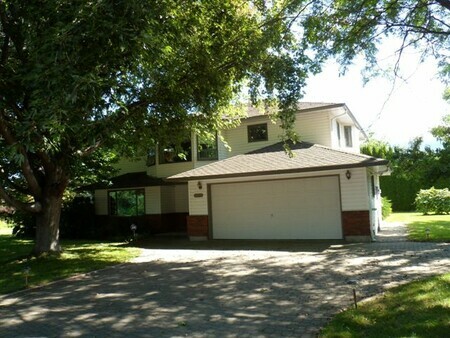
There's no place like home!
Stay posted, I'll be putting more art and stories of my "new" life more often now that we have all the "mod cons" like wifi, TV, phone, and address!
Now for some more "local" explorations! And more photos of things to paint once I get settled in my new studio in the fall!
First stop: beautiful Quadra Island, a 10 minute ferry ride from the central Vancouver Island city of Campbell River. We had our travel trailer set up at Herriot Bay for the winter & it was time to move in--at least for 10 days. That seems to be the top limit of our stopping times for the year!
I got the bike out and started to ride--on to spectacular Rebecca Spit, right around the corner from us. And, to my total amazement, what did I see, in Drew Harbour, surrounded by the local boats and kayaks?
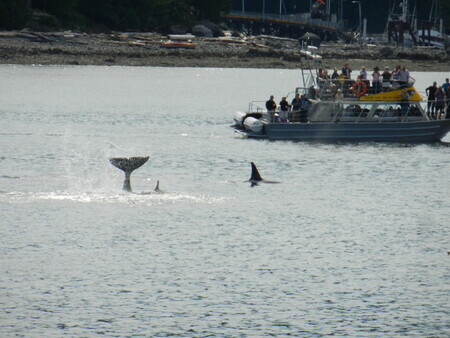
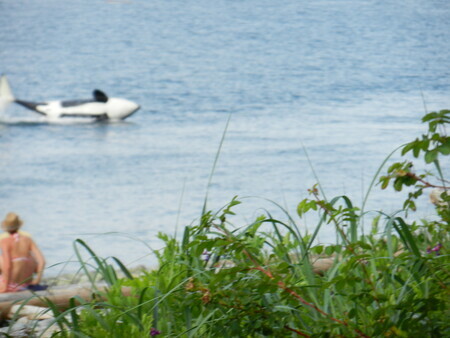 So close to shore, you could hear them breathing!
So close to shore, you could hear them breathing!
I followed them while they put on a show for at least an hour, back out into Herriot Bay and around Rebecca Spit. I had to run back to get my bike (which I had hastily dropped at the end of the Spit, while I got my camera out to get some shots). I thought they would head further out towards Cortes Island but they hugged the Quadra coastline heading south towards the next accessible viewing beach about 3 km away.
I definitely got my workout that day, and lots of excitement too!
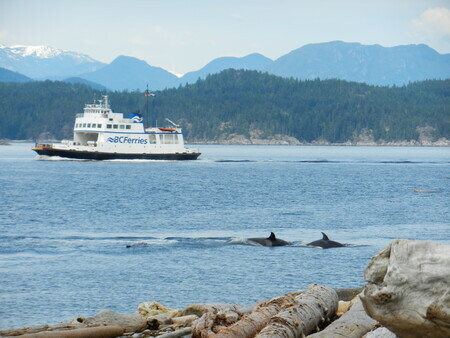
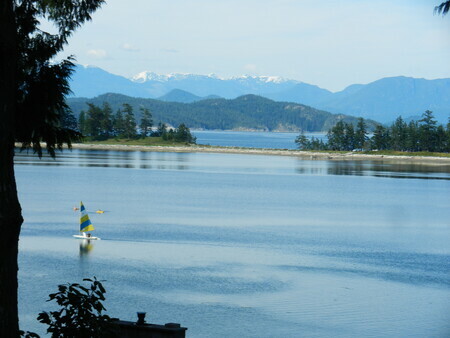
Here's a photo of Rebecca Spit without all the excitement happening--just a little piece of paradise in our own back yard.
I got lots of photos and inspiration to paint from, now have to carve out the time. This summer I viewed the John Cleese Utube presentation on creativity (about 35 minutes)--his keys were to set aside the space, the time, more time, have confidence (no ideas are bad at this stage) and inject some humour. Very worthwhile watching if you'd like to see the full view and catch all his jokes about how many ____s it takes to change a lightbulb along with the meat!
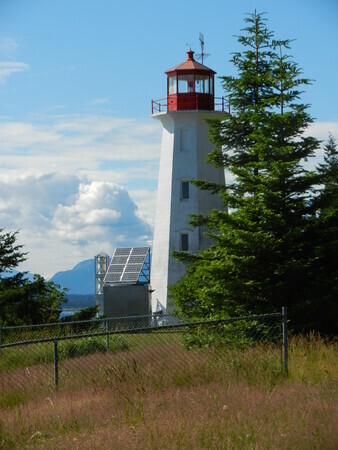 The photos at right is of Mudge Point Lighthouse, on the south end of Quadra Island. I got a few great photos to continue my lighthouse series of paintings. You might have seen some in my gallery pages...I'm becoming more aware of symbolism and the iconic nature of lighthouses, along with their mostly spectacular settings, hold a strong appeal for me as a landscape artist.
The photos at right is of Mudge Point Lighthouse, on the south end of Quadra Island. I got a few great photos to continue my lighthouse series of paintings. You might have seen some in my gallery pages...I'm becoming more aware of symbolism and the iconic nature of lighthouses, along with their mostly spectacular settings, hold a strong appeal for me as a landscape artist.
 We really enjoyed lots of hikes on Quadra Island--they were a little less travelled than many we have been on this year. Of the 5 we did we saw no-one else on the trails. The fishing was good too--we ate fresh rockfish several nights, and again I got lots of reference shots for future paintings.
We really enjoyed lots of hikes on Quadra Island--they were a little less travelled than many we have been on this year. Of the 5 we did we saw no-one else on the trails. The fishing was good too--we ate fresh rockfish several nights, and again I got lots of reference shots for future paintings.
This is Discovery Passage, near where the Ripple Rock explosion in the 1950s was the largest non-nuclear explosion in history. It cleared a very hazardous island from the middle of this strait between Vancouver Island and Quadra Island--setting the path for gigantic cruise ships transiting up the coast to Alaska.
In fact, my year of travelling started on one of those cruise ships, last year in August. However, we transited this passage in the dark on the first night, and the last night before we returned. The waters look still now, at slack tide, but there is still a very strong current running through here and small boats have to take care.
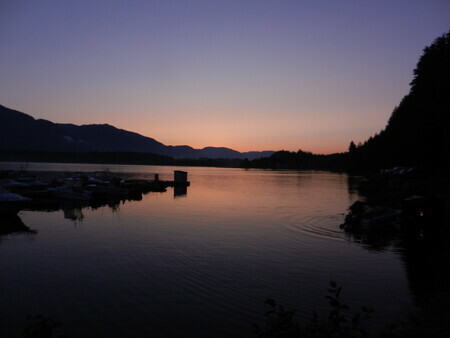 We finally packed up the travel trailer and got ready to resume our nomadic summer on Vancouver Island. Next stop: a fishing trip at Port Renfrew, on the West Coast at the south end of Vancouver Island. This trip was payment for a commissioned work I had completed the year before, and the fish were biting!
We finally packed up the travel trailer and got ready to resume our nomadic summer on Vancouver Island. Next stop: a fishing trip at Port Renfrew, on the West Coast at the south end of Vancouver Island. This trip was payment for a commissioned work I had completed the year before, and the fish were biting!
Along with limiting on halibut and rockfish, and almost limiting on salmon, we picked up cod, and 2 days worth of beautiful fresh crabs. Part of the discovery was a great restaurant in Port Renfrew where you can take your catch in and they will cook it for you--$5 per crab, $8 if you want a side dish. So fresh and lovely, excellent idea and cooking--you'd wonder why you don't see that idea around other places in the world.
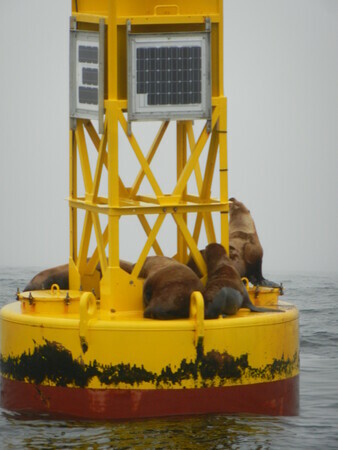
We had two great days of fishing although out on the entrance to Juan de Fuca Strait there were big swells and it was cool and foggy. We were accompanied by big sea lions near "J Buoy" and wonder how these animals find their way there, about 13 miles offshore!
Again I saw the orcas off Botanical Beach, and watched them fishing for about an hour. They were too far out to photo, though, and didn't do so much jumping about as the ones at Quadra. Maybe they were too busy fishing!
We said goodbye to Port Renfrew and drove back into the sunshine and heat of the east coast of Vancouver Island. It's funny how much climate difference there can be in 50 km, when the mountains, the sea air, the rain shadow effect all combine.
The rest of the summer has been filled with visiting family and friends, with a short trip up to the north end of Vancouver Island, and Cape Scott, to top it off. We stopped at historic and beautiful Telegraph Cove, which is a small town on stilts (a la Ketchikan, on a very small scale) famous for orcas and the nearest spot to Robson Bight, a renowned cove with a rock beach that the orcas rub on. Here, we did some more hiking but no orcas were to be found. However, we did happen to have an even more rare sighting of the Stanley Cup, the NHL tropy! Somehow I doubt if the cup has ever been to Telegraph Cove, or ever will be again! Willie Mitchell, the LA Kings hockey player, brought the trophy to the area where he started playing hockey and was just getting into the helicopter to leave when we drove by!
Cape Scott was a wilderness adventure and we free-camped at Holburg, right beside the Red Ibis pub (the only place in town!) for two nights after a trailer tire went flat on the 2 hour gravel road in. We walked out to beautiful San Josef Bay just as the rain swept in, and walked back to the truck for our lunch. It was another entirely different weather zone, and although the Port Hardy people said it was "hot", at a sunny 17 degrees Celsius, it definitely was not to us!
The last highlight was stopping into the massive home studio of famous watercolourist artist Gordon Henschel and meeting hime and wife Anne. I have seen his work for many years (he started painting the year I was born!) and it was a great priveledge to be welcomed so warmly, and to see just a little of the body of work he had created. Still painting at 80!! I can only hope that my career gets to his level!
Now you are updated on what I've been up to--hardly "painting away in the world"! However I do have now about 1900 reference photos from several corners of the world--nature, animals, buildings, people, historical spots, and some that I'll use as the basis for some abstracts. I am looking forward to getting into our new place in Summerland September 1, and starting to carve out a studio from the chaos. My first show in the Okanagan is booked--"Santa Presents" in Penticton, November 3 and 4, at the Trade and Convention Centre, so I'll have to get working on some new paintings to unveil then! Hope you can see them "in the flesh", so to speak!
It'll probably be a month before the dust settles and I post again, until then, enjoy the rest of the summer, and think about making a trip to the Okanagan to see my new studio!
We were so happy to be greeted by longtime friends at Schipol Airport in Amsterdam! We hadn't seen them in 10 years, since we parted in Sydney, and after 6 weeks of "hard travel" in Africa it was lovely to have a home to spend time in. Not to mention hosts that are great travellers themselves who seemed to know exactly what sights we would enjoy seeing--all the wonders of the Netherlands and Belgium that we had never even imagined.
Apart from windmills and scenic canals everywhere, we saw lovely countryside, since our hosts (like, I suppose, lots of Dutch) were farmers before retirement and live in a small town in Belgium, so the crops everywhere (and I mean, EVERYWHERE! It was amazing how much land was under cultivation, at minus elevations, dug out from the sea) were duly noted as we passed by to more amazing and beautiful cities and engineering works.
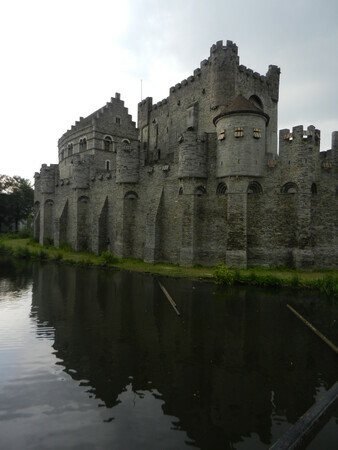 Ghent was the first and closest city to explore after we had driven through Holland, and seen the World Heritage site at Kinderdijk (last photo in my previous blog) with 23+ windmills dating back hundreds of years.
Ghent was the first and closest city to explore after we had driven through Holland, and seen the World Heritage site at Kinderdijk (last photo in my previous blog) with 23+ windmills dating back hundreds of years.
The Castle of the Counts photo (left) with its dungeon and torture instruments didn't appeal to us--on the inside at least. And this blue sky was about the last we saw before a storm and rain came over and dampened our outdoor exploration.
Not to worry, we ended our walk with sausage, cheese washed down by some great Belgian beer, right on the canal!
And I did get some more photos suitable for painting in future, of the lovely canal frontage, some moody skies over bridges, and the guys in front of a whole window full of different kinds of Belgian beers. It will take a few more trips back to taste even half of them!

Another day, it was off to see the big sea gates that were built after a great flood in 1953 killed 2000 Dutch people when the dikes were breached. There was a big enquiry and commission formed to make recommendations to prevent such a tragedy happening ever again, and a huge 25 year project was undertaken to build sea gates which we explored. All parties came together on the principles of protecting the tidal environment (a huge bay with major shellfish fishery, and lots of birdlife in the estuary), financial positions (the cost was were to come in on budget, and annual operating costs were to be maintained at minimal levels, which they still --amazingly--are, 50 years later) . I wonder if such a project could be undertaken so successfully in this era.
First, however, we stopped at the historic town of Middleburg, which was on the island which had been swamped years before. As we explored we saw some of its wonderful architecture, and enjoyed the central square marketplace, and had our first taste of Dutch sushi--it was the nieu herring season and apparently the Dutch eat it whole, raw, with some chopped onions sticking to it. Actually it was quite delicious! But I only wanted one.
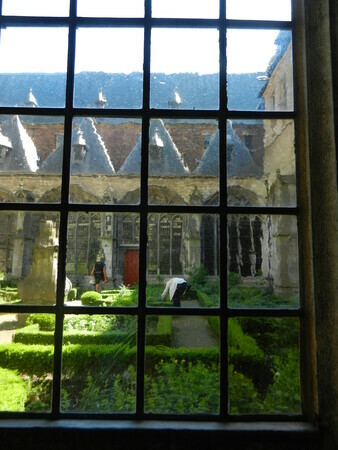 One of the places our hosts showed us which is unique to Belgium was the historic beguinages, which were a little like monasteries except they were run by women, non-religious, who wanted to do good works for the underpriveledged in their area. They built residences which usually faced onto quiet and enclosed gardens, and were lovely peaceful places to have some refuge from the busy streets and cities around.
One of the places our hosts showed us which is unique to Belgium was the historic beguinages, which were a little like monasteries except they were run by women, non-religious, who wanted to do good works for the underpriveledged in their area. They built residences which usually faced onto quiet and enclosed gardens, and were lovely peaceful places to have some refuge from the busy streets and cities around.
We found other quiet spots inside the grand cathedrals that are so prevalent in Europe, although personally after a very short while the religious component, especially to the art contained inside, starts to become a little too much for me.
So, it was lovely to find this beautiful green garden close in the cathedral in Middleburg. I loved the light coming through the old glass and will probably do a painting from one of my shots here. Another enjoyable place!

And on another day we explored beautiful Brugges--and of course had to buy some Belgian chocolates, do a boat ride on the canal, and again try some more beer--kriek for me, this time, on a warm summer afternoon in a lovely market square.l\
We had some other great days sailing (including crewing in one evening regatta in which we came second), and biking around the lcoal countryside--as yhou do in the lowlands!
And then it was on to London for a week exploring Jolly Olde and visiting with cousins. We actually did an orbit in the plane over central London, and saw the Houses of Parliament, Buckingham Palace and the Tower of London from the air on a sunny evening, and that was as close as we got. We rented a car and circumnavigated the big city--visiting Bedfordshire and Cambridge ( beautiful city, with its many colleges along the river--cathedrals and museums and full of young educated upperclass Brits). The countryside there was beautiful too--lovely rolling green hills with old churche steeples rising above old graveyards wurrounded by trees. Idyllic, you might say. More painting material!
Then a brief drive (by North American and African standards!) down to Kent for a pub lunch with some Aussie friends, and on to Bournemouth--where my roots are on my father's side. It was great to be back in the area after a visit four years ago.
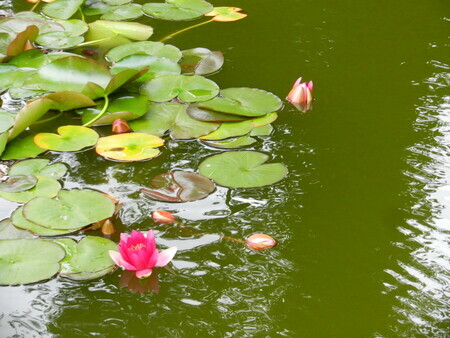
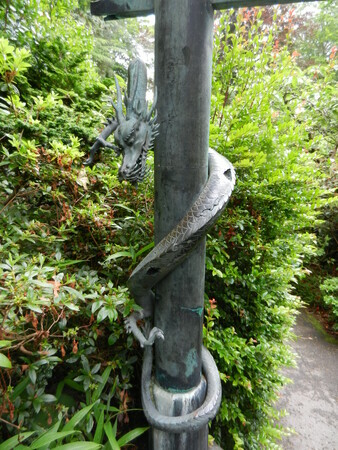
As always in Britain, and despite all the complaints about the cold weather, I was stunned by the beautiful gardens everywhere--from cottages to huge public gardens--England was at its best and getting ready for any Olympic guests that might not care so much for the sports!
I really meant to get some photos of the lovely thatched cottages with the roses climbing up the walls around doors and windows--sadly I got one of a thatched roof with its animal made of straw on top (the thatcher's trademark, apparently) at sunset but reserve that photo for a future painting--you'll have to watch for that one in future!
And the last night in England was spent with some great cousins who have bounced and boomeranged from Bournemouth to Australia and just recently returned to England to live in a little town in the New Forest (actually 1000 years old!). It ws great to see them on the other side of the world although I'll surely miss them when I head back to Australia in early 2013.

We had a few walks on the moors of the New Forest, looking at the ponies there and getting a little more exercise after all those pub lunches and good food and drink.
Then it was farewell to England, and back for another two days of Brussels, the canal works of southern Belgium (amazing feats of engineering--one of the boat lifts was 73 metres high!) and a visit to the First World War battlefields and the last post at Ypres.
I'm not a war buff, or even fan, but it was a very moving moment to be at the monument that was created in Ypres for the unfound soldiers of WWI, all 125,000 of them, with all the names ritten, battalions and regiments from England, Scotland, South Africa, India, Australia, New Zealand, Canada. At 8 pm, as every night since the early 1920s with the exception of 4 years during WW2 when the Germans had possession of Iepers (as Ypres is called in Belgium) the ceremony and the Last Post is played. The evening we were there, there were lots of Australians from private schools in Melbourne so "Advance Australia Fair" was also played. It was enough to bring tears to many faces, including our hosts, and my own.
A last day spent in Amsterdam (which didn't impress us as much as the countryside surrounding) was the end of our international travels for the year.
Next post will be about our Vancouver Island adventures for the summer--with some photos of fish, whales, and lots of spacious Canadian western scenery! Hope you enjoyed these last blogs--and are inspired by them to see some of this wonderful world, yourself!
After the East Africa safari finished we flew to Johannesburg, South Africa. About an hour into the 4 hour flight, I looked off to the left and was amazed to see the very top of Mount Kilimanjero poking up through the clouds. It seemed to be about the level we were flying!! What a massive mountain--it was so exciting to point at it and say "That's where we were, just on that top icy part, only 3 weeks ago!" Then we saw the Rift Valley again, and flew along it for a long way (it runs from Egypt to Mozambique) before we finally got onto flatter and very dry country.
Heading into Joburg airport it seemed that we were back in a very civilized country, compared to Kenya and Tanzania. We could see lots of many-laned highways, and power lines, and western-style and sized houses! I was very hopeful that we would only have "Western" toilets everywhere we went--after the pit toilets that were .... well, you could say the norm but even that was not quite correct for East Africa!!
However there was still a huge sense of unease, we found after we got settled into our guesthouse for the night. All those lovely houses were surrounded by huge walls, gates, barbed wire or electric fences on top, and guards. It was not safe to walk outside at night and there were quite a few horror stories of invasions and muggings throughout the countryside even, not just in the city.
Still and all, we enjoyed the drive to the hunting lodge in Limpopo province, about 4 hours north of Johannesburg, through beautiful countryside.
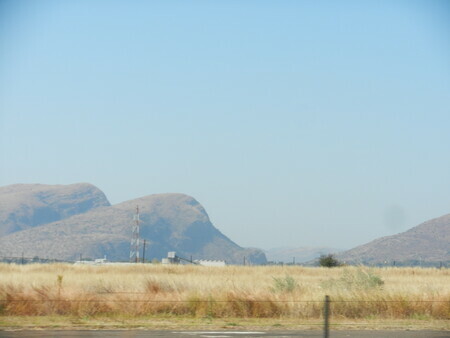
Hard to believe we were in the middle of winter! It was very dry, and warm in the daytime, and cool at night, between 7 and 25 degrees C. Apparently in the summer it is not uncommon for weeks of 40+ degree weather. Glad we weren't there for that!

The lodge was lovely and very friendly, and we were out every day seeing lots of familiar animals, as well as some new ones. I was happy with this little sketch of a bushbuck (bossbok in Africans) that I did from one of our host's tropies. Pieter holds the world record for another bushbuck.

The nyalas there were among the most beautiful antelopes in the world, I think, and I got some great photos to paint them from, as well as doing a good sketch. The males are quite differently coloured from the females, and when they were first discovered they thought they were different species. This is a lovely male that was hanging about the property!
The males are quite differently coloured from the females, and when they were first discovered they thought they were different species. This is a lovely male that was hanging about the property!
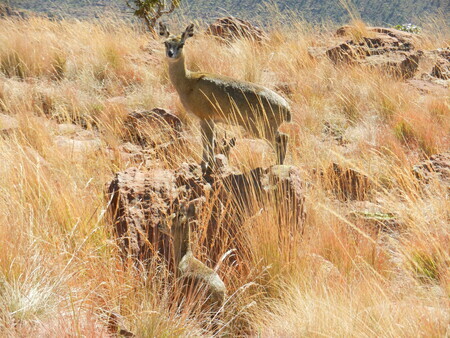 We also drove to the top of those beautiful hills I showed you earlier, in another national park, and saw these klipspringers. They are a small antelope who stand on their tippytoes on the rocks--the name means "Rock Jumpers"--very apt!
We also drove to the top of those beautiful hills I showed you earlier, in another national park, and saw these klipspringers. They are a small antelope who stand on their tippytoes on the rocks--the name means "Rock Jumpers"--very apt!
After a week in the Limpopo province, we drove back to Johannesburg and flew on to Durban, on the Indian ocean, where we rented a car and spent the last 4 days of our African trip exploring the area. One last safari...ok, make it two days!
We drove north to St. Lucia National Park, which is a lagoon-based park containing leopards (we didn't see any more), hippos, crocodiles and again lots of birdlife.

This was the best photo I got of an African Fish Eagle catching a fish right in front of us!

OK, a few more lion sightings at Emfolozi National Park, which is known for saving the rhinos. We saw both white and black rhinos, giraffes, hyenas again, giraffes, kudo, impala, wildebeest, nyalas, elephants, and two more cheetahs, on our last day of safari. One was just resting beside the impala he had just killed, hiding under a tree so the other predators didn't steal his kill from him.
All in all, we had a fantastic time in Africa. If you want to go sometime, contact me and I'm happy to recommend the Nairobi tour outfitter--he did a fantastic job organizing the East Africa portion of our trip and you'll find that his prices are far lower than you will pay your local agent.
Next, on to Holland!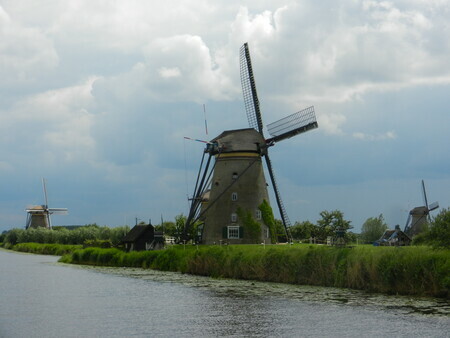
Once we decompressed from our adventure climbing Mount Kilimanjero we started on safari in Tanzania and Kenya. We continued to be amazed by the contrasts we saw, every day...poverty (along the road with most of the people, it seemed) and wealth (our safari lodges were the most gorgeous places we've ever stayed), black and white, dry (desert-like landscape, even in wet season) and rainforests, and places filled with people and their domestic goats, sheep and cattle contrasted with the spectacular national parks filled with amazing wildlife.
We started at Lake Manyara in the beautiful Rift Valley that runs south through most of Africa. Our hotel sat on the escarpment of the Rift Valley, with a view right into the National Park.
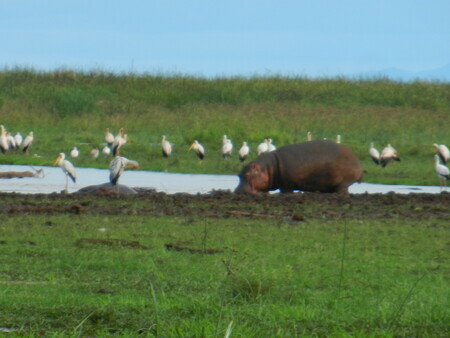 The first day in the park was amazing--our initial sightings of hippos, elephants, dik diks (tiny antelopes that are always in pairs, sometimes with a baby), Thompson and Grants gazelles, impala by the bucketload, giraffes, zebras--everything we wanted to see-- we thought!
The first day in the park was amazing--our initial sightings of hippos, elephants, dik diks (tiny antelopes that are always in pairs, sometimes with a baby), Thompson and Grants gazelles, impala by the bucketload, giraffes, zebras--everything we wanted to see-- we thought!
How silly of us--there were endless kinds of antelopes, giraffes, still had all the wild cats (and we got some great photos over the 17 days), and the birdlife was equally amazing.
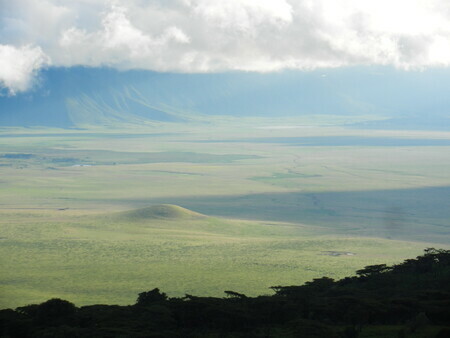
After two nights at Lake Manyara we moved onto what I thought was one of the most spectacular places on earth--the Ngongorongorong Crater.
Our lodge was (again) perched on the rim of the crater with a spectacular view of the inside that we would explore the next day.
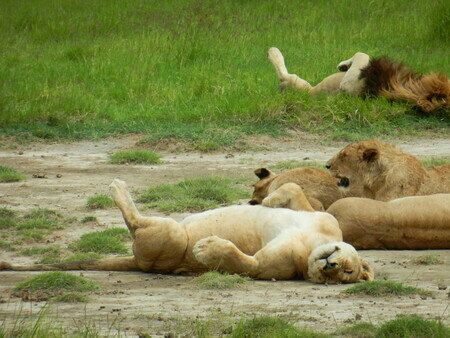
Here's the life of a lion pride after a kill--they were so full they couldn't move at all.
It almost seemed safe enough to get out of the van...but maybe not.

Here was the next pride we encountered, who had just been chased off their wildebeest kill by about 25 hyenas.
This was the van in front of us, but other lions in the pride were sitting just under our van too!
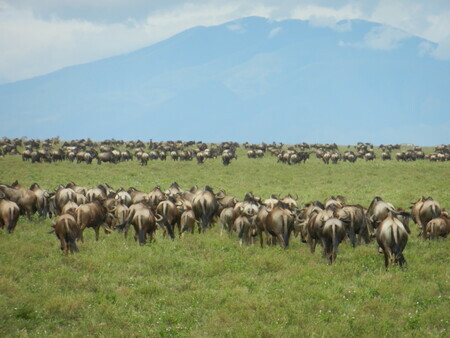 The next day we moved on to the Serengeti National Park--another iconic African park. We made a little detour from our planned path to see the great migration at the south end.
The next day we moved on to the Serengeti National Park--another iconic African park. We made a little detour from our planned path to see the great migration at the south end.
2.5 million wildebeest, accompanied by zebras and the predators...what an amazing sight to see!
Unfortunately for us, without our knowledge, we were also being watched by predators and had about $1000 in various denominations stolen from our bag somewhere in this couple of days--either from a hotel safe or on this particular day where we were travelling to the next hotel. The guide assured us we could leave our bags in the safari vehicle while we climbed a hill to see the migration from above--which was the only time we left the bag unaccompanied with enough time for someone to go through it and take some monies (large bills) from various envelopes, leaving partial amounts there so we didn't recognize the loss for 2 days. Be warned, if you travel in Africa--we thought we were being secure but obviously not enough.
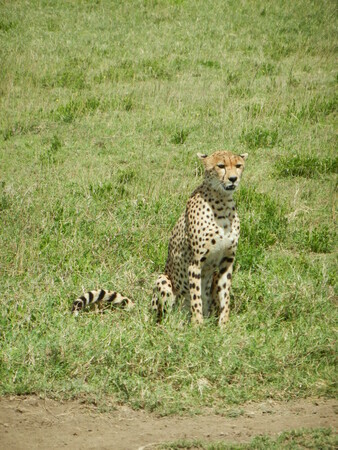
Well, we didn't want that to be a damper on what was otherwise a fantastic experience--so on we went, seeing our first (and almost last) cheetah--what a beauty! He couldn't care less about us, wouldn't look at us (like most of the cats, they just ignored us!)
Then, more lions, elephants, antelopes, buffalos and giraffes right close to our hotel...the list goes on!
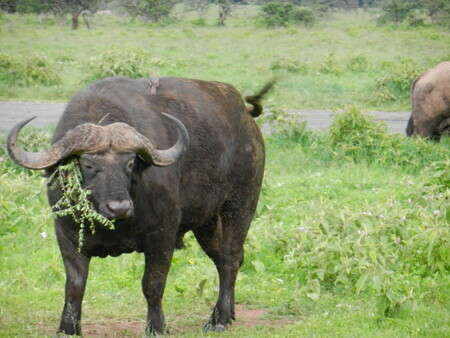
This guy had an interesting head-dress!
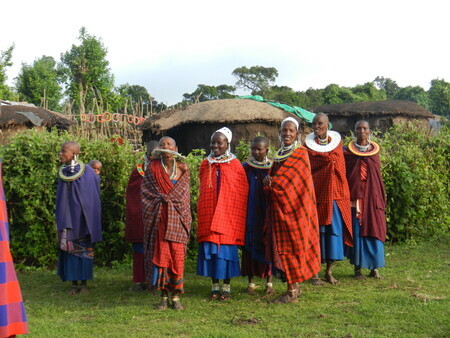
And it wouldn't be a full description without talking about the local tribes. We visited a Masai village and had a good look at their colourful clothing, their traditional huts made of wood covered with cow dung, and roofed with grass/straw. No sanitation, or power, needless to say. Shocking living conditions for us Westerners, not to mention the multiple wife situation, the missing and rotting teeth, the lethargic babies, the desparate look in their yellowed or red eyes.
I thought I might like to paint some, but I came away saddened by the experience so I'm not sure I can do that.
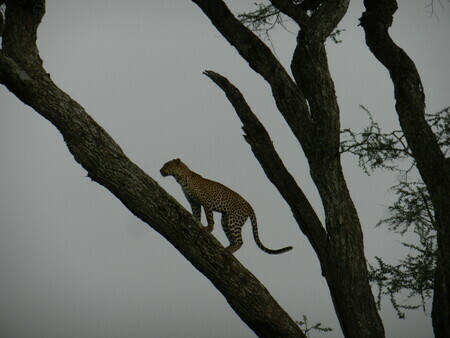
The other exceptional experience we had in the Serengeti was seeing two leopards close together in one day--very unusual, according to the guide. And then, one of them actually got disturbed by the rain and came out of its hiding place up high in the tree.
Wish I had my wits about me, and had the movie setting on my camera! Anyway I got a good shot of it in the tree.
Next stop was the Masai Mara, in Kenya, where we had a night in a deluxe tented lodge. Each hotel seemed to get better and better--we could hardly believe it--and arriving at Lion Camp in the dark, after a very long day on the road, just having discovered the theft, somehow helped us start to recover.
Kenya had more wonderful parks to discover--we were wondering by this time what more we could possibly be impressed by. Then we saw the lion pride attacking a couple of buffalos who had strayed from a large herd. Five of them were hanging off the back of one of them when part of the herd came to chase them off so all the action was very exciting.

Meanwhile some of the same lion pride were putting on a road show for the rest of the viewers! This particular safari vehicle was wide open, and the three people inside were definitely not leaning outside to see what this little fellow was doing!
We visited Lake Naivasha, known for birdlife (350 species) and growing flowers that are shipped to Holland's flower auction every day, crossed the equator 4 times before lunch on another day, and loved Lake Nakuru National Park, known for its white and black rhino population.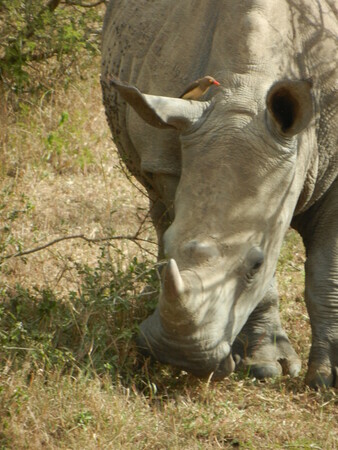
On the morning we were leaving, we spotted 22 rhinos, again before lunch!
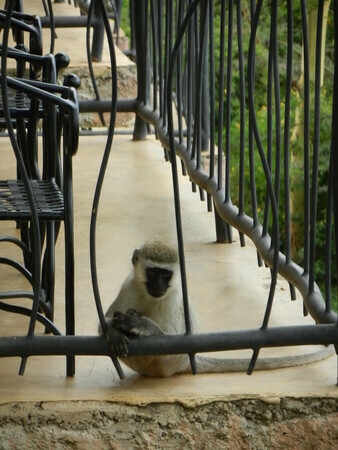
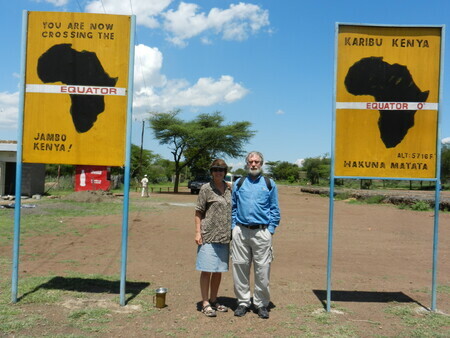
Then north in Kenya, closer to the Somalia border, where there are some places that are a little risky for tourists to be. We had to drive the long way around to Samburu National Park because one road had been closed to tourists for a couple of years--due to bazooka-carrying bandits (purportedly Somalians) who take no prisoners, apparently. One more issue in East Africa that shocked us naive Westerners--the recent (last 5 years) of violence, tribal wars, and lack of effective enforcement, to add to the poor infrastructure (a "Kenya massage" is given by the roads while driving--they are so rough!) and corruption of governments. The unrest is expected to worsen later this year as there are general elections.

But we had beautiful places to see, and yet more and different wildlife too. My husband and I just don't get tired of looking for animals, and the deserts of Samburu National Park provided some new species including the desert oryx (from my sketch), which looks like the gemsbuck that we saw later in South Africa.
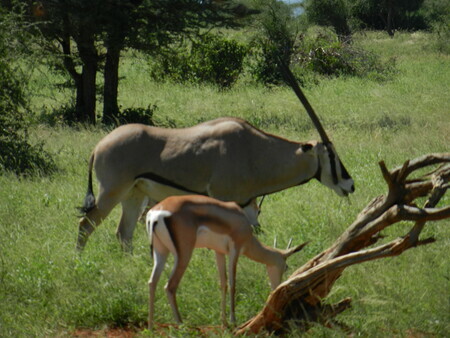
This one is standing behind a Thompson gazelle, which I have also sketched, below.

And I should also note that the local Samburu tribes, related to the Masai but not so well known, and seemingly a little more advanced, gave us a warm welcome and provided some of that colour I was looking for without the desparate poverty. Or maybe I was just getting used to it by then??
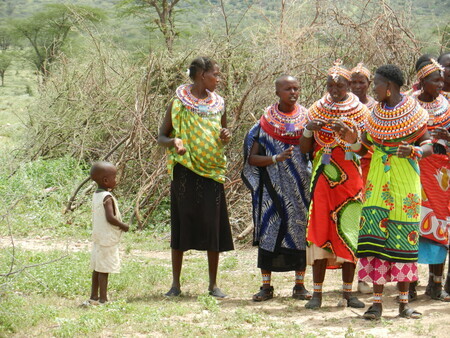
 They all seemed quite healthy--as actually did most of the Africans.
They all seemed quite healthy--as actually did most of the Africans.
Funny, we didn't see any obesity, very little overweight people, everyone walked along the roadside. There were very few cars (except in Nairobi), and lots of happy looking kids along the road, waving at us, smiling and looking quite happy. Even 5 year olds tended their herds of 5-10 goats, cattle and sheep, carrying big sticks and keeping (mostly) off the road. We noted that there were no MacDonalds, only a couple of KFCs in Nairobi itself, and no other fast food chains in East Africa. Wonder if there's a connection?
With those photos, I think it's time to end that chronicle of our adventures in East Africa. Next it's off to South Africa, and then on to Europe.
Who has time for painting??
Just got home to BC after a very exciting 8 weeks in Africa and Europe. With 1500+ photos to edit, and stories capturing Tanzania, Kenya, South Africa's Limpopo province and Durban/Zulu coast, as well as Holland, Belgium and a little bit of the UK, I might do a bit of a series of updates. So stay tuned, I'll be on it shortly!
First stop--Nairobi, Kenya. We arrived late one night and took a day to get oriented, meet our tour operator & guide and find an upgraded lodging at the famous New Stanley Hotel, courtesy of Jireh Tours. We were welcomed by many "Jambos" by a smiling face at every desk, every floor, and treated to 5 star colonial hotel courtesy that we could never have imagined. The people and facilities here made us much more comfortable in a very foreign environment and culture--our first in the 3rd world, other than a trip to Acapulco Mexico a few decades ago for me!
After a day cautiously exploring the city centre around the Stanley, we took off for the David Sheldrick Orphaned Elephant and Rhino Centre which was amazing and provided a welcome glimpse of not-so wildlife, as well as great photo material.
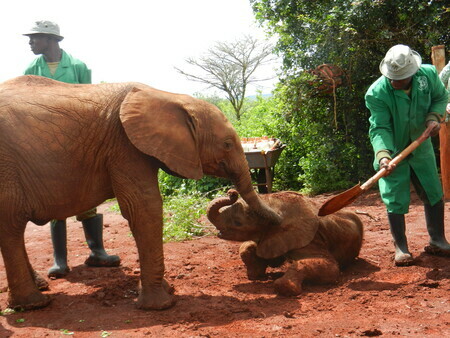
Next was the Giraffe Centre. It was amazing being so close to 5 gentle giants--2 younger ones (at only 12 feet tall!) and 3 larger ones. There was hardly anyone else there and we got to feed them with a guide for over an hour.


Next, off to the famous Carnivore restaurant which was a little disappointing...so we headed "home" through 2 1/2 hours of a traffic jam, with vendors coming by our van selling, variously, shoes, vests, games, soccer balls, statues, peanuts, fruit, and who could tell what else!! Entertainment value of that and of the 2 lanes of road encompassing 4 lanes of cars, motorcycles, trucks and pedestrians was incredible!
Next day we headed out towards Arusha, our Tanzanian centre for climbing Mt. Kilimanjero. I didn't get any photos at the shocking border crossing! That was another experience altogether--2 sets of customs. Incoming to Nairobi airport a few days before they had only taken our photos, but on the way out they wanted retinal scans and 2 full sets of fingerprints! After crossing 100 metres of dirt, vendors, parked trucks, animals and who knows what else (no man's land!) the Tanzanians only wanted 2 forms, photos, US$50 and took off with our passports along with all the rest of the passengers. Scary until 2 seasoned North American travellers (one an NGO worker in Tanzania) stood waiting with us for their return via the shuttle bus driver.
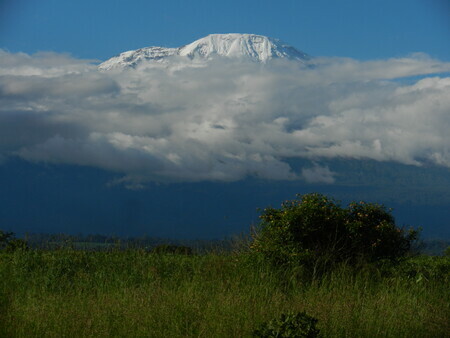
Then, Arusha and quickly on to a real lifetime highlight experience--climbing Mount Kilimanjero. 5895 Metres (over 19,500 ft)! The top of Africa and the highest by far of anything we've ever hiked--even the gates where we started were 1970 metres (6500 ft) which is not far off our previous high hikes! We had 3 days up including acclimatization at Homboro Huts (3720 metres--over 12,000 ft) and an evening sleep at the top Kibo Hut (4703 --15,500 ft) before we started our final stage at 12:30 am. It was a long moonlit climb for 6 hours til dawn, and a last scramble (guide-assisted for me) to the crater rim at Gilman's hut (5685 M) where I almost called it a day. But then, the magnificent snow, ice, and rock-covered crater rim tempted me around to Stella Point and from there our 2 guides pushed me on 150 metres higher, and about 1 km longer, to Uhuru Peak. Thanks Issa (guide) & Justin (assistant guide on the day, cook the rest of the hike) for the support--I wouldn't have made it there on my shaky legs and unsteady breath without them, of that I'm sure!
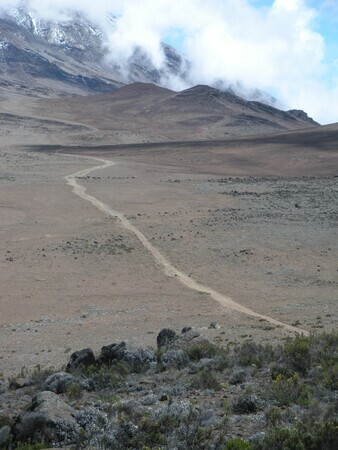

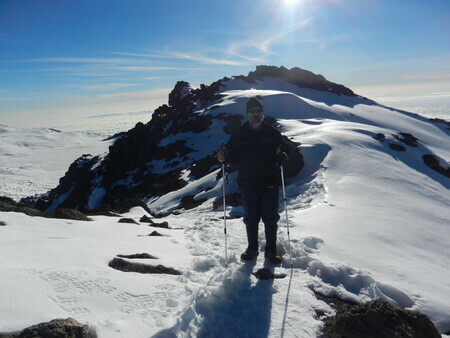

The whole experience at times seemed surreal, like I was dream-walking--at other times it brought out my love of incredible alpine scenery crossed with volcanoes--and then there was the background knowledge popping out periodically that I was at the top of Africa--in a spectacular place, with amazing people doing things that I had only dreamed of before. How priveledged am I to be able to enjoy this rich life experience? And that awareness stays with me particularly in this third world country and one that I am beginning to appreciate!
Not sure how this will change my paintings--I've been looking at African art forms, especially wildlife that we'll be seeing next on safari...and wondering about how to capture the variety of human life & tribes that exists here. Now that we are not restricted in our luggage (we really pared down to essentials on Kili--sadly I didn't even take my sketchbook!) I'll be trying to draw daily along with getting some great photo reference material for the future.
Giraffes & elephants I now have lots--now for more animals in the wild! On safari we go--will be a couple of weeks before posting again, I'd guess! See you then!
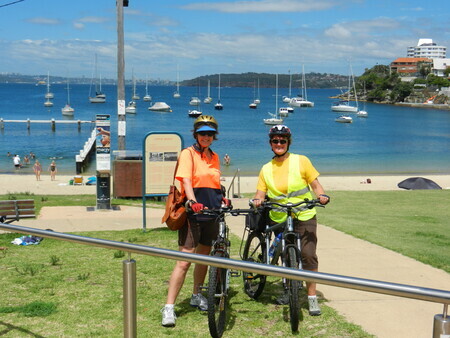 As I write the sun has broken through the clouds that have brought spring showers to the Pacific Northwest. We have been here for 5 days now and I hope I'm almost over the jet lag from our 30 hour and 7 time zone flight from Australia, just in time for Tuesday's departure for Nairobi. That journey will consist of two legs--9 hours to Amsterdam, one hour getting through Schipol airport to catch the 11 hour flight onwards. Along with a 10 hour time difference I'm glad we have 3 nights planned for resting in Nairobi before we take the 6 hour shuttle bus to Arusha where we will spend another night before we start our trip up Mount Kilimanjero. We hope to reach the top peak in Africa on May 10!
As I write the sun has broken through the clouds that have brought spring showers to the Pacific Northwest. We have been here for 5 days now and I hope I'm almost over the jet lag from our 30 hour and 7 time zone flight from Australia, just in time for Tuesday's departure for Nairobi. That journey will consist of two legs--9 hours to Amsterdam, one hour getting through Schipol airport to catch the 11 hour flight onwards. Along with a 10 hour time difference I'm glad we have 3 nights planned for resting in Nairobi before we take the 6 hour shuttle bus to Arusha where we will spend another night before we start our trip up Mount Kilimanjero. We hope to reach the top peak in Africa on May 10!
This week, while resting, unpacking, repacking, buying more travelling gear, and clearing up all the mail and tasks that have accumulated here while I was away for 4 months, I have a few minutes to review all the Australian and New Zealand photos before clearing out my camera. I thought I'd put a few more highlights out there and show you what I've been painting in preparation for the next two months.
At Little Manly Cove--one of my favourite Sydney spots
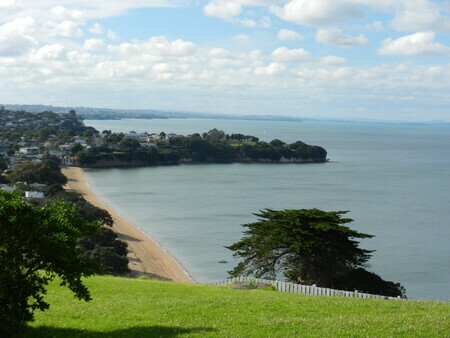 On Auckland's North shore, near sunset
On Auckland's North shore, near sunset
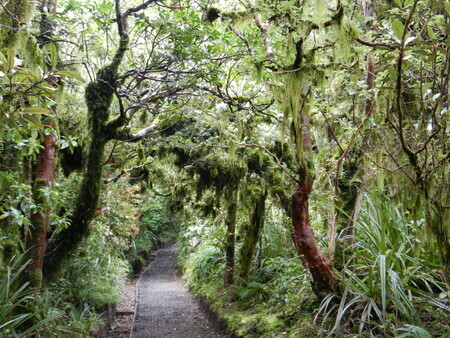 Goblin Woods (future painting subject) on New Zealand's North Island
Goblin Woods (future painting subject) on New Zealand's North Island
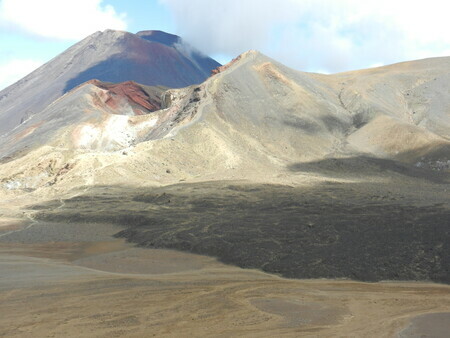 Tongiraro Crossing--one of the top 10 one-day hikes in the world. We'll have to look for more! It certainly was a star of the NZ tour.
Tongiraro Crossing--one of the top 10 one-day hikes in the world. We'll have to look for more! It certainly was a star of the NZ tour.
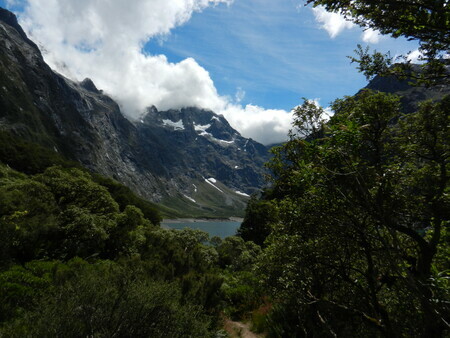 Approaching Lake Marian on the Milford Sound Road--another great hike before we started the Grand Traverse (The Routeburn Track combined with the Greenstone Track), South Island, New Zealand
Approaching Lake Marian on the Milford Sound Road--another great hike before we started the Grand Traverse (The Routeburn Track combined with the Greenstone Track), South Island, New Zealand
 Back to Aussie--one of the many beautiful parrots that we always look for. Apparently African birdlife is also fantastic--so watch for more photos in future!
Back to Aussie--one of the many beautiful parrots that we always look for. Apparently African birdlife is also fantastic--so watch for more photos in future!
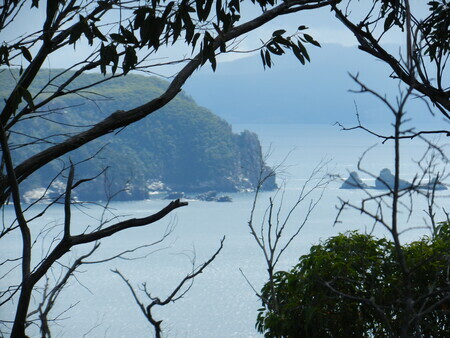 One of our fantastic hikes on the Tasman Peninsula--the transported prisoners might not have appreciated their location but we certainly had lots of freedom to explore and marvel at its beauty.
One of our fantastic hikes on the Tasman Peninsula--the transported prisoners might not have appreciated their location but we certainly had lots of freedom to explore and marvel at its beauty.
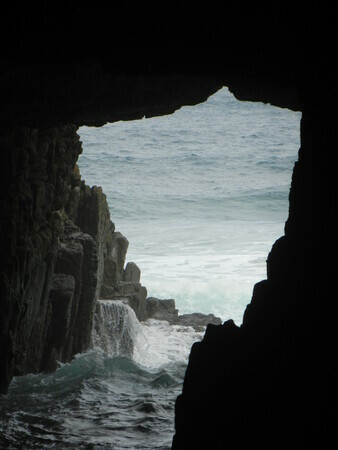 See the map of Tassie formed by the outline of the rock cave? This is on the south end of the Tasman Penninsula as well. Another fantastic (short) hike.
See the map of Tassie formed by the outline of the rock cave? This is on the south end of the Tasman Penninsula as well. Another fantastic (short) hike.
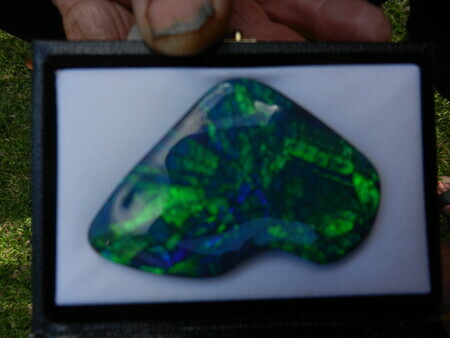 Now THIS is really something to appreciate: a 120 carat opal worth about A$120,000. It was mined by a friend of a friend. He might sell it for less than $100,000 as the opal market is a bit soft right now. If you know someone who has that kind of money, and wants to get their wife/girlfriend/fiancee a spectacular, one-of-a-kind gift, I can put you in touch with him!
Now THIS is really something to appreciate: a 120 carat opal worth about A$120,000. It was mined by a friend of a friend. He might sell it for less than $100,000 as the opal market is a bit soft right now. If you know someone who has that kind of money, and wants to get their wife/girlfriend/fiancee a spectacular, one-of-a-kind gift, I can put you in touch with him!
Meanwhile I was priviledged to see it!
It came from a mine near to where my wedding ring stone was found. These are Lightning Ridge, NSW opals, not to be mistaken for the white opals of Coober Pedy in South Australia (many thousands of kilometres away)
And now, on to some of the art I've been creating...
 This is a small semi-botanical print that I am very happy with, created at Camp Creative in January.
This is a small semi-botanical print that I am very happy with, created at Camp Creative in January.
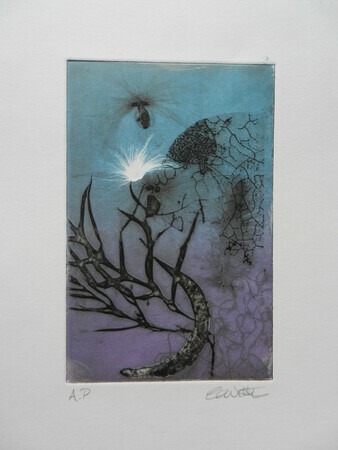
Another slightly larger, that I loved the colours and the effect of the stephanosis seed (in white)
And here's a few animal sketches to get me ready for Africa!

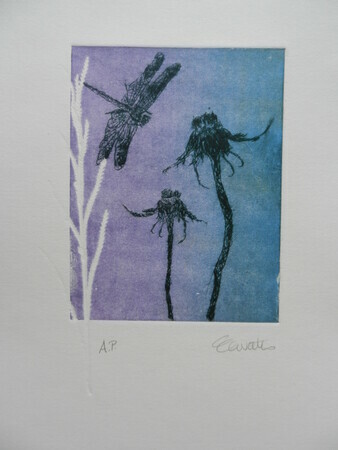
That's about all for now, I must get back to my packing. The next time I post will likely be a month away, after Mount Kilimanjero and some safari action. We won't be carrying a computer with us in our travels so will be subject to whatever technology is available to rent.
Happy trails!!
My life of travel continues to astound me. It's hard to believe almost one third of this exciting year has passed and an even more exciting period is coming up! The downside--trying to make travel arrangements when you're already travelling! In a very connected world some of the spots we've been have not had the best or easiest internet access for me to keep up-to-date with my blog, with photos, and with organizing the Africa and European segments of the next trip. That's all getting rectified before May 1 when we leave for Africa, I hope!
Since the last blog I've at least got a few small paintings done of some African animals that I hope to see in May and June--just a little prep. I'll try to get photos of them on here when access permits. We've been doing lots of driving, from Melbourne to Queensland and back, in the last 3 weeks. I'd guess we've put another 6000 km on Molly, my little old Aussie Mazda that is still kicking along strong. Along the way we've seen lots of friends and relatives, and explored some new territory too.
Highlights--kayaking on the Kalang River at Urunga, near Coff's Harbour, NSW; spending Earth Hour dining by candle-light on a high deck under the gum trees, with the surf playing on the beach as background music, getting back in the sea and pools along the way. Now it's down to the last 4 days in Australia until next year. Lots to get organized, paintings and art supplies to sort out and decide what to leave here in storage and what to return to Canadian storage until my studio is open in the fall. Sometimes I think it'll be nice to be settling again!
So, just a short posting for today, we'll see you again from somewhere in the world! Until then hope you're following your passions too.
Since I last posted we've been doing even more travelling--first to South Australia through a new route to us. We drove through central west Victoria, passing through Ballarat and the lovely little farming centre of Hamilton. On the way, I managed to snap an iconic Australian image:
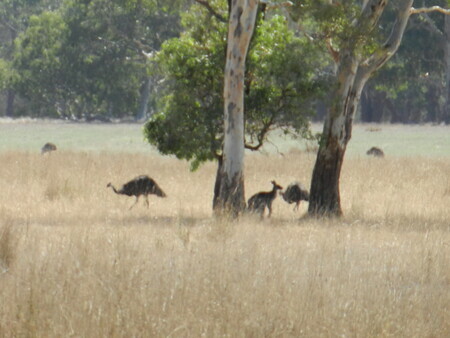
Emus AND Kangaroos in the same field! There was only one kangaroo but about 25 emus (you can see some in the background).
After that it was on to beautiful Port Elliot, a historic village on beautiful Horseshoe Bay (NOT the one in West Vancouver!) Coincidentally (or not) a painting I did of Commodore Point, on Horseshoe Bay, is the March image on my 2012 calendar! I might have to paint some more of the local scenery--here's another shot of the pier near the beach.
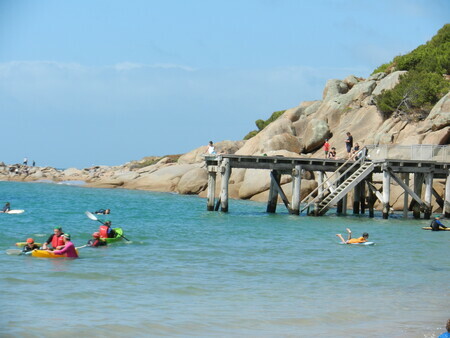
There was a little surf carnival on at the time--look at the colourful outfits the kids were wearing!
We had a great weekend, reuniting and barbecueing with long-lost cousins, anday trip to historic Strathalbyn gave some artistic inspiration.
Then, after about 5 visits over the years to the town of Victor Harbour, I finally walked over the tramway/causeway to Granite Island, and around the island.
Along the way, we saw the things you'd hope and expect to see--seals, birds, lovely sea and coastal iew--and then some unexpected things--like this camel, waiting for someone to pay for a seaside ride!! Who'd have thought, in this area, to see that offering! Must be intending Victor Harbour to be the next Cable Beach!

After that it was on to Tasmania. First stop was MONA (The privately operated Museum of Old and New Art that just opened last year, to some controversy). A "must see" for anyone visiting Hobart--especially for an artist like me. My review--definitely confronting (most of the works were either death or sexually oriented displays), and a few I thought were disgusting--like the Cloaca Machine, and the x-rays of rats imitating the stations of the cross. I hesitate to callk them art, myself. I guess my preferences run more towards traditional, conformist or classical art. In the end I was quite disappointed--but don't let that stop you from going there to see what all the hubbub is about.
Next it was off to explore the wild west coast of Tassie--lots of rainforest and reservoirs and water, and not too many people about.
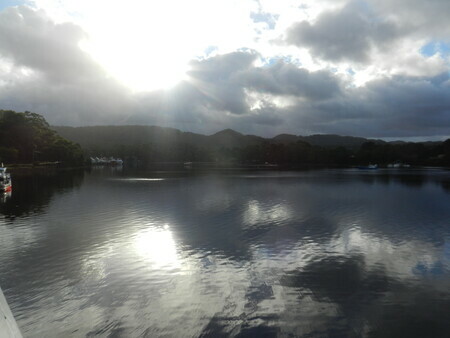
This is a photo of MacQuarrie Harbour, at Strahan, where we got a marvelous boat cruise around the harbour, to Sarah Island (the first convict prison in Australia, pre-dating Port Arthur), and up the Gordon River. It was a lovely west-coast day--a little reminiscent of BC's West Coast, and of New Zealand as well.
Distinctly Australian, however, with polarized views on the preservation of timber vs. jobs, the convict history and heritage, and the iconic woods with the famous Huon pine, Sassafras, King Billy Pine, myrtle and beech trees.
Pushing on to the north west coast, we enjoyed another walk up the Nut at Stanley (we had done it last year and were happy to do it again, for more training for Mount Kilimanjero), and a great lighthouse tour at Table Cape, and a 2 kilo crayfish meal for 4.

This is before, while he's still alive on the scales, all $156 of him!
Then it was on to another historic lighthouse at Low Head, near Devonport. I can feel more paintings in my "Lighthouse" series coming on--I love the symbolism, the settings, and the structures of the lighthouses around the world. I've seen some calendars of lighthouses and that gave me the idea of a series of paintings.
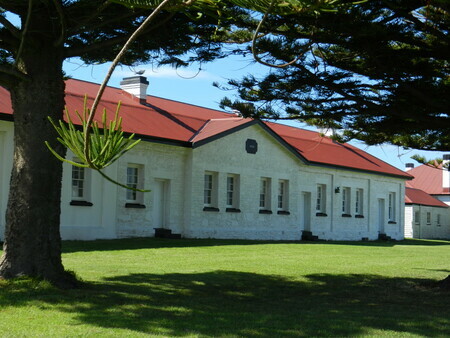
This is the museum at the Low Head Pilot Station, which is close to the lighthouse. It's a lovely old precinct with 45 heritage listed buildings sitting on a very large green. The lighthouse itself is about a kilometre away.
Then we were away south to the Tasman Peninsula which surrounds Port Arthur. We spent a wonderful week exploring more convict heritage sites like this one.
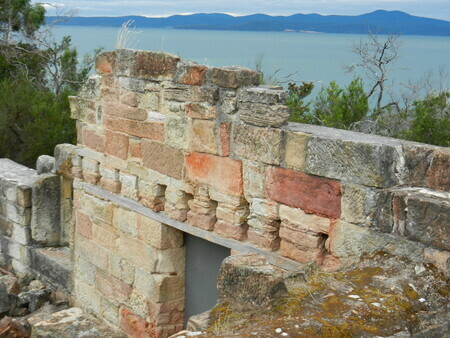 This is a ruin from the Coal Mines Historic Site about 15 km from Port Arthur. The worst of the prisoners were sent to it to mine coal, guarded by soldiers who had much better accommodation there.
This is a ruin from the Coal Mines Historic Site about 15 km from Port Arthur. The worst of the prisoners were sent to it to mine coal, guarded by soldiers who had much better accommodation there.
It is a beautiful setting today but apparently the convicts were in fear of being sent there to work and often were kept in solitary cells with no windows, measuring 6 feet by 6 feet, totally lined with stone. Must have been hell in the winter.
We also visited Port Arthur again, a couple of times, as there is much more there to see than the two hours that we had last year.
The best part of the week was all the training we then did for hiking Mount Kilimanjero in 6 weeks--there are some beautiful coastal paths and we did three Cape walks and saw some remarkable formations including "Remarkable Cave".
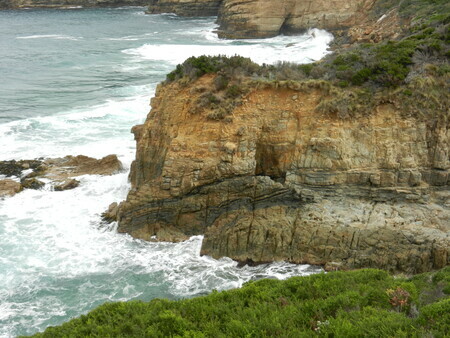
This photos is on the way to Cape Hauy.
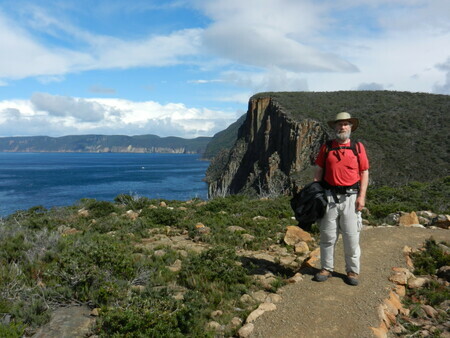
The next is from the Waterfall Bay to Fortescue Bay track, which took 6 1/2 hours and was the best hike we did, on Sunday with our
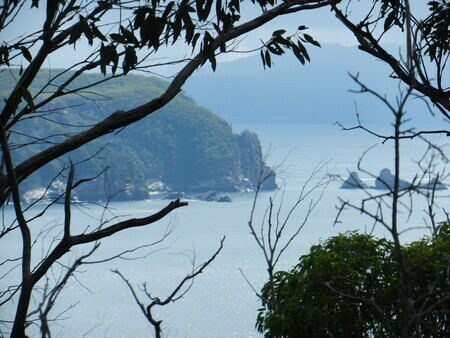 wonderful friends and hosts who had the knowledge of the area, and provided great company, food and beds at the end of each day. We were very spoiled! Hopefully we can handle the less stunning accommodation and beds we'll expect in Africa!
wonderful friends and hosts who had the knowledge of the area, and provided great company, food and beds at the end of each day. We were very spoiled! Hopefully we can handle the less stunning accommodation and beds we'll expect in Africa!
So many beautiful places, so much travel, and lots of photos and inspiration for future paintings. I haven't had my brushes out for over a month, and the infrequent sketching I've een fitting in hasn't been enough to make me happy. I could consider that I'm using photography as my art form at the moment, to capture the colours and beauty of my surroundings--but I hope to get a few things painting in the next month as our travelling pace slows a bit.
Three months of our adventure-filled hyear have flown by--and there are anther five to go feobre we start to settle in our new home after September. Still having too much fun!
I'll leave you with an image of our last night in Nubeena--a great ending to the Tasmanian saga. See you next time!
